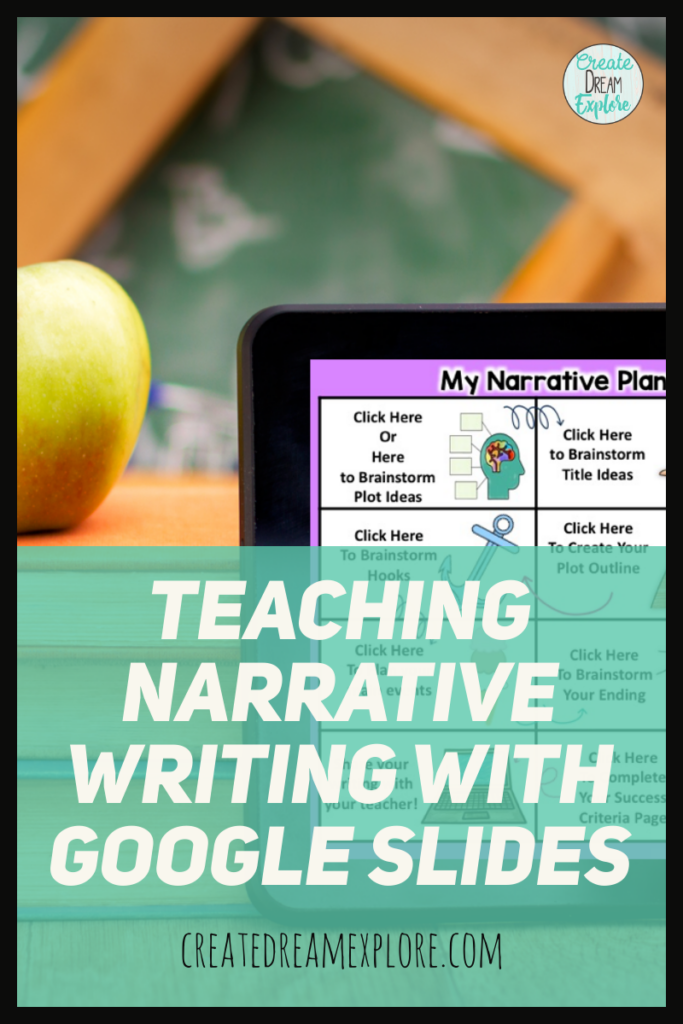Planning a narrative can be tricky for many students. I know mine always like to jump right in with the writing and I love their enthusiasm but I find that if they don’t have a plan their writing ends up lacking details.
Before I had Chromebooks and ipads I would always provide a variety of graphic organizers for students to plan out their writing with. Narrative writing can be particularly tricky. As much as students love writing stories, they often have difficulty with including all of the parts. They want to jump right to the end where the exciting stuff happens and in the process they leave out important details.
This is where graphic organizers come in!
I love using Google Slides for graphic organizers because I’m able to make them bright and colorful and we don’t have to worry about the cost of ink.
Here’s a look at some of the ones that I have included in my Digital Narrative Organization set.
The first slide shows students the order that they should complete each slide. When they click in each box it will take them to the matching graphic organizer.
Their first two organizers have them brainstorming plot ideas for four or five different stories. They will then choose the idea that they liked the most for their narrative. I included two different options for brainstorming but you would only assign one of these slides per student. At the time that I created this I had a few students in my class that I felt would benefit from having 5 ideas and then also a few students who had difficulty coming up with ideas so I liked the option of having only 4 ideas for those students.
Once they have selected their narrative plot idea they can they move on to brainstorming a title. Some teachers would rather have their students brainstorm title ideas at the end and that is okay, you can have students complete this slide at any point in time.
I included two option for the character brainstorming slides (one male and one female). Depending on how many main characters a student plans to have, they can just duplicate the slides to create more.
This is an important piece of narrative writing that I find students often don’t consider. When we read narratives in the middle grades they usually go into great detail about the setting. Common feedback from teachers to students is, “Please add more detail” but then sometimes we aren’t specific enough with out students. We need to be clear about what adding more details means. Once my students have brainstormed the setting I can ensure that they include details about it in their story.
Completing a plot outline helps students to visualize where there story is going to go. Providing this structure helps students to stay focused and when they get down to writing they have a clear idea of where their story is going. I tell them that this part should be brief. They only need to include one sentence here (two tops). The first time I did this I had a few students that tried to write out their whole story in these little boxes so since then I have been more clear with my students that this is meant to just be a point form outline.
We spend a lot of time at the beginning of the year brainstorming hooks (bold beginnings). If you haven’t talked about hooks with your students I would consider doing a mini-lesson or two about the various ways they could start their story in order to grab the reader’s attention.
Since they have already written a brief plot outline this is where they can go into slightly more detail about the three main events in their story. I had my students expand on their ideas from the plot outline in 3-5 sentences each.
My students loved coming up with different ways to end their story. In fact, once we had written all of our narratives we spent some time looking at alternate endings and how changing the ending could change the reader’s feelings about the text.
This slide is one of my student’s favorite parts of the process. They get to design the cover for their “book”.
I designed a sample to show them and in fact I ran through all of these graphic organizers with my students and we wrote a collaborative story before they started on their own writing organizers.
When they were finished writing their narratives I had them complete a self-evaluation. I found this to be really helpful as I saw many students go back to make revisions once they did their self-evaluation.
You can find this resource in my TPT store here or by clicking on any of the images.
Happy writing!
For more ideas on how to use Google Slides in the classroom, check out this post and this one for ideas on how to use Google Forms in the classroom.
The form you have selected does not exist.

















